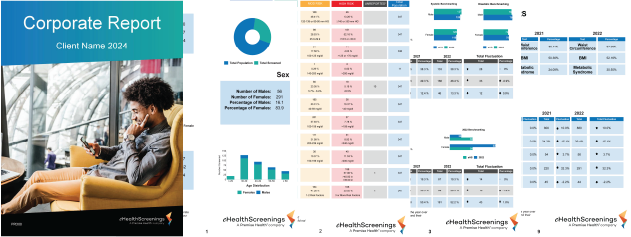
We know just how important it can be to interpret biometric health screening results on an individual employee level. But now that your employees understand their results, what should you, as an employer, do with all the data collected from your biometric screening events? It’s time to interpret and leverage your data reports to improve health outcomes and decrease spending for your organization.
The value of biometric screenings for employers
Biometric screenings aren’t just essential for individual health assessments but also for providing valuable insights to employers, including:
-
- Condition prevalence: Biometric screenings may reveal that previously unnoticed chronic health conditions like diabetes, high blood pressure, and high cholesterol are common in an employee population, and allow employers to support members in managing them.
- Benefits gaps: Biometric screening event data provides employers with a tool to assess your population’s health data and can reveal valuable enhancements you can make to your benefits package, like access to nutrition, fitness, and wellness coaching support.
- Untapped savings: By identifying high-risk individuals in your population, you also identify high-cost individuals who may have habitual hospital visits, high medication costs, and more. Providing support to these members reduces unnecessary medical spend and saves on your bottom line.
Through aggregate results and cohort results, employers can get actionable insights into the health of their employees and the effectiveness of their current benefits plan. Let’s explore what these two specific datasets look like, and what action items they can highlight for employers.
What you can learn from corporate aggregate results
While individual results are confidential, aggregate data combines all individual screening results, which can reveal significant health trends across your employee population; especially when compared year over year. This data is essential for customizing wellness programs to address specific health challenges.
For instance, if a trend of elevated blood glucose levels is identified, targeted interventions like nutritional counseling, diabetes prevention workshops, or introducing healthier snack options in the break room can be implemented. These strategic actions not only address specific health concerns but also show a proactive commitment to enhancing employee wellness.

The power of cohort reporting
To truly measure progress, relying solely on claims data is an insufficient measure – because it’s looking back at what has already happened, not what’s happening right now. Cohort reporting empowers employers to compare aggregate data for the same subset of employees who have participated in screenings over multiple years.
This approach helps track gradual changes in workforce habits, which are often not immediately visible nor captured in claims data until a condition is already diagnosed. Cohort reporting can validate whether your wellness initiatives are effectively directing your workforce towards healthier behaviors, in addition to highlighting the long-term impact of your health strategies.

Partnering for effective reporting
Because biometric screenings can offer such expansive insight into your organization’s health, it’s critical to work with a biometric health screening vendor that offers a range of analytical tools and makes the process simple and secure.
Confidentiality and access to data
Confidentiality is paramount in biometric health screenings. Individual results are kept confidential, shared only with the employee or a designated third-party wellness provider as applicable. Individual results are never shared with the employer; instead, results are presented as aggregate data that anonymizes and segments results.
To satisfy the need for instant participant feedback, choosing a vendor that provides real-time results through booklets and online access is beneficial. It’s important that these reports are clear and concise, highlighting high-risk areas effectively for better health management.
Engagement and participant satisfaction data
Engagement and satisfaction during biometric screenings are key to making sure members continue to participate year after year. At eHS, we maintain a high-quality experience by integrating feedback mechanisms into our services. After each screening event, we conduct satisfaction surveys for both clients and participants to gather valuable insights that allow us to continually refine and tailor our services to better meet the needs of the populations we serve.
By utilizing diverse reporting tools, organizations can gain a comprehensive view of their health initiatives’ effectiveness, ensuring they are well-informed and able to make strategic decisions that lead to better health outcomes and enhanced participation in wellness programs.
eHealthScreenings provides comprehensive reports for enhancing understanding and enabling informed decision-making for individuals and their organizations. Ready to learn more? Contact us to learn more about biometric health screenings with eHealthScreenings.
